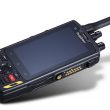Motorola responds to emergency with 86 truckloads of communications gear
Motorola, Schaumburg, IL, has been responding to customer requests for emergency help since hijackers used domestic passenger jetliners to attack New York and Washington on Sept. 11. President George W. Bush had called the attacks an act of war and declared a national emergency.
Motorola’s employees have worked around the clock to expedite shipments to support police, fire, ambulance and other emergency services in the affected areas, said Christopher B. Galvin, the company’s chairman.
Chuck Jackson, vice president of system operations for Motorola’s Commercial, Government and Industrial Solutions Sector, said that the company’s crisis center in Schaumburg, IL, closed last night after seven days of activity. He said that with the restoration of air freight and other services, continuing responsibility had passed to Motorola crisis centers in the New York and Washington areas. Jackson is one of 30 members of the Chicago crisis management team who coordinated Motorola’s response during the past week.
“Motorola business and logistic teams and manufacturing facilities worldwide will remain on full alert and will continue to give priority to public safety emergency orders as needed,” Galvin said.
Galvin said that as of yesterday, Motorola had delivered at least 86 truckloads of communications equipment to field teams and customers in the New York City area, Virginia and Maryland. In addition, seven planes carried Motorola equipment into the affected areas last week and over the weekend.
Three communications systems were delivered last week, including separate trailer-mounted 900MHz and 800MHz radio systems in New York city, and another trailer-mounted 800 MHz system at the plane crash site in Pennsylvania. These systems are similar to those used to support communications at large sporting events.
In addition, an 800MHz, 15-channel communications system was delivered to New York to provide back-up communications for the city’s Empire State Building site, which itself was a back-up for a communications system on the roof of the World Trade Center. With the primary site completely destroyed, the city wanted a back-up for the Empire State site immediately. With help from vendors and a Dayton, OH, dealer, P&R Communications, Motorola workers produced the system in 30 hours. Under normal conditions, such a system takes about three weeks to assemble.
P&R supplied a trailer-mounted, 107-foot tower, antennas and grounding equipment. David Reeves, co-owner and vice president of P&R, also used his vendor contacts to expedite the preparation and shipment of a Kohler generator to Schaumburg for the system. Then Reeves, along with P&R Project Engineer Glenn Hochwalt and Systems Specialist Tim Eardly, drove the trailer to Motorola’s Glen Rock, NJ, staging area and explained how to deploy the tower.
Reeves said of his company’s participation in the project, “It was kind of fulfilling for us that we could do something. You watch TV news about the attacks, and you get mad and upset.”
Motorola has delivered 9,500 portable radios, 16,000 batteries and 3,000 chargers so far. About 120 base stations and nearly 5,000 pieces of miscellaneous accessories, such as cabling and antenna equipment, have been delivered. Motorola has also delivered 700 Iridium satellite telephones to emergency agencies in the New York City area. And the company provided 1,000 cellphones to an insurance company for its policyholders in the affected areas.
Motorola has also donated 10,000 IDEN multifunction phones to various federal, state and local government agencies, plus about 88,000 batteries, chargers and other accessories. Nextel Communications, Reston, VA, provided the phone service.
Galvin said that the Motorola Foundation is donating $1 million in support of relief efforts, dispersed to the New York Police, Fire & Rescue; the Federal Employee Education and Assistance Fund (World Trade Center / Pentagon Fund); General Relief Fund in New York; Abilities Inc.; and Employee Match to the One Motorola Responds Fund.
“We all have the opportunity to redefine what it means to be heroic. We must not let terror paralyze us. Instead, we must focus our energies on collaboration and reconstruction. We need heroes and heroines of epic proportion working to strengthen the world one step at a time,” Galvin said.









